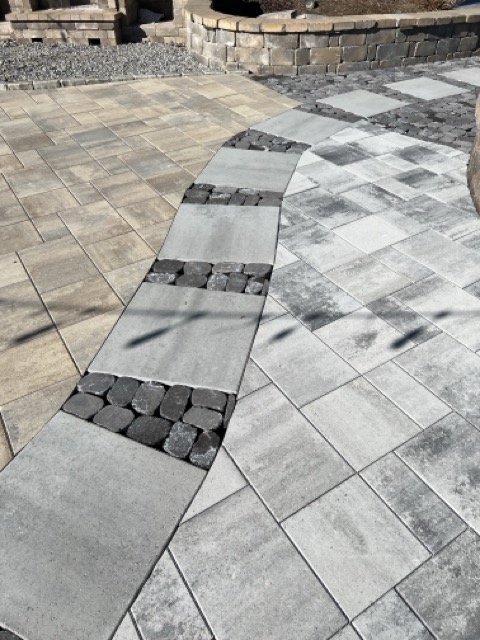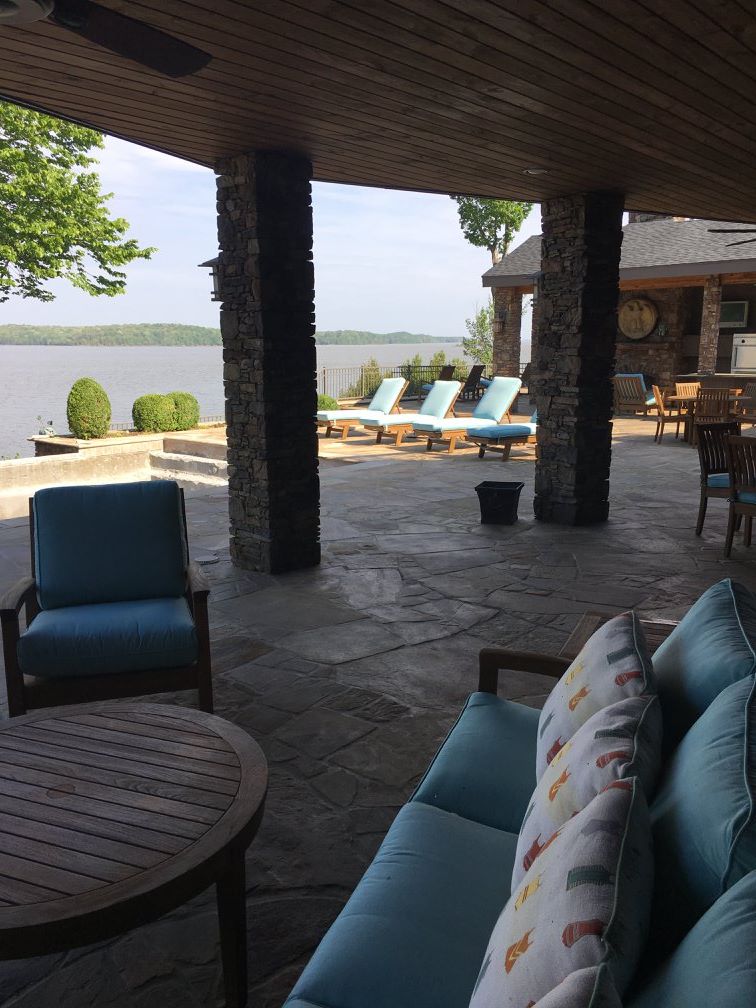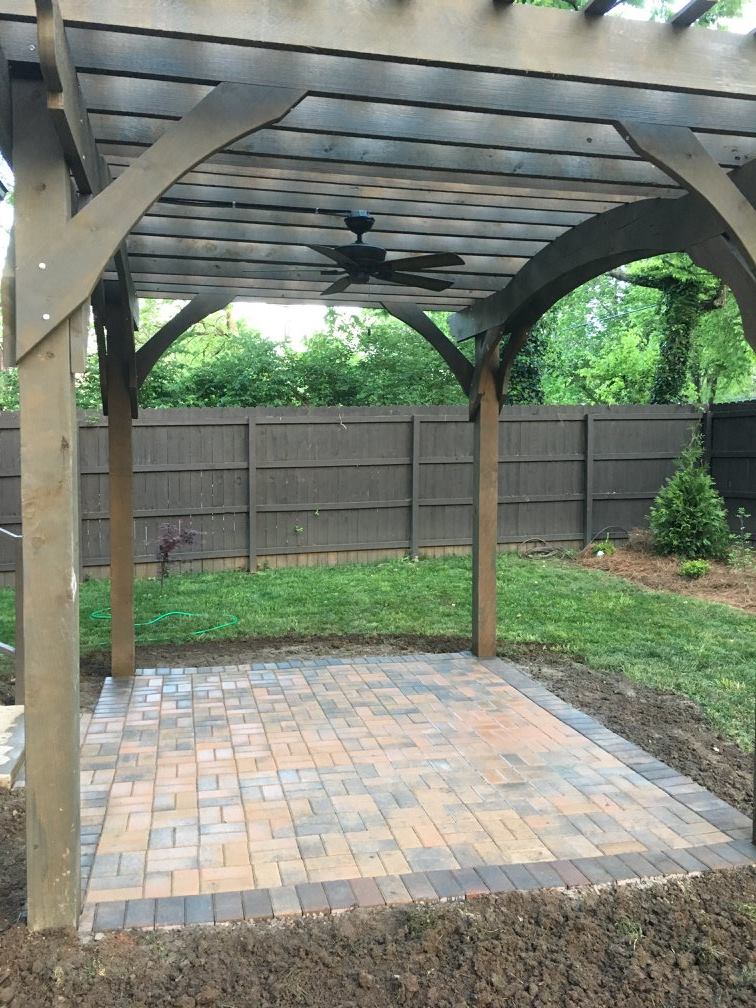Selecting the right hardscape material for your patio, driveway, or walkway is a crucial decision that affects both the immediate appearance and long-term value of your outdoor spaces with professional hardscaping services. The stamped concrete vs pavers comparison represents a choice between two popular hardscaping solutions, each offering distinct advantages for different design goals, budgets, and maintenance preferences.
Stamped concrete provides seamless, customizable surfaces at $8-18 per square foot installed, offering unlimited design possibilities with lower initial costs and faster installation timelines. Pavers deliver superior durability and repair flexibility at $10-25+ per square foot installed, providing individual unit replacement capabilities, enhanced drainage, and premium aesthetic appeal through expert paver installation.
This comprehensive guide examines every aspect of the stamped concrete vs pavers comparison, helping you understand the installation processes, long-term performance, maintenance requirements, and design possibilities for each material so you can make the best choice for your specific hardscaping project, climate conditions, and lifestyle needs.
Understanding Hardscape Materials
What is Stamped Concrete?
Stamped concrete is a decorative concrete technique where patterns and textures are imprinted into freshly poured concrete using specialized stamps and molds. This process creates surfaces that mimic natural stone, brick, tile, or other materials while maintaining the structural benefits of concrete.
Key Stamped Concrete Characteristics:
- Seamless surface: Continuous surface without joints or gaps
- Pattern variety: Unlimited design possibilities with custom stamps
- Color options: Integral colors and surface stains for custom appearance
- Monolithic construction: Single pour creates unified surface
- Texture replication: Realistic imitation of natural materials
Stamped Concrete Components:
- Base concrete: Standard concrete mix with proper reinforcement
- Color integration: Integral color mixed throughout concrete
- Release agent: Powder preventing stamp adhesion
- Stamping tools: Specialized molds creating patterns and textures
- Sealer application: Protective coating enhancing appearance and durability
What are Pavers?
Pavers are individual hardscape units made from concrete, clay, or natural stone that are laid in interlocking patterns to create durable surfaces. Each paver is manufactured separately and installed with sand joints, creating flexible surfaces that can accommodate ground movement.
Key Paver Characteristics:
- Individual units: Separate pieces allowing flexible installation
- Interlocking design: Units lock together for structural stability
- Joint flexibility: Sand-filled joints accommodate movement
- Material variety: Concrete, clay brick, and natural stone options
- Modular system: Standardized sizes for easy installation and replacement
Paver Components:
- Base preparation: Compacted gravel and sand base
- Bedding sand: Level sand layer for paver placement
- Paver units: Individual hardscape pieces
- Joint sand: Sand filling spaces between pavers
- Edge restraints: Borders containing paver installation
Stamped Concrete: Detailed Analysis
Stamped Concrete Design Options
Pattern Varieties:
- Stone patterns: Ashlar slate, random stone, cobblestone
- Brick patterns: Running bond, herringbone, basket weave
- Tile patterns: Large format tile, wood plank, geometric designs
- Custom patterns: Unique designs created with specialty stamps
- Textured finishes: Smooth, broom finish, exposed aggregate integration with landscape design
Color Options:
- Integral colors: 20+ standard colors mixed throughout concrete
- Color hardeners: Surface applied colors for enhanced durability
- Acid stains: Chemical stains creating variegated, natural appearance
- Water-based stains: Consistent colors with UV stability
- Antiquing agents: Accent colors highlighting pattern details
Surface Treatments:
- Acrylic sealers: Basic protection with moderate enhancement
- Polyurethane sealers: Superior durability and chemical resistance
- Penetrating sealers: Deep protection without surface film
- Anti-slip additives: Texture enhancement for safety
- Decorative overlays: Thin toppings for existing concrete renovation
Stamped Concrete Advantages
Design Flexibility:
- Unlimited patterns: Custom stamps create any desired pattern
- Seamless appearance: No joints or lines interrupting design
- Large areas: Ideal for extensive surfaces without pattern breaks
- Color consistency: Uniform color throughout surface
- Custom integration: Can incorporate logos, borders, or unique elements
Cost Benefits:
- Lower initial cost: $8-18 per square foot installed
- Faster installation: Complete projects in 2-5 days typically
- Labor efficiency: Fewer skilled workers required than paver installation
- Material economy: Less expensive than premium paver materials
- Reduced excavation: Requires less base preparation than pavers with proper drainage
Performance Benefits:
- Structural integrity: Monolithic surface with excellent load-bearing
- Weather resistance: Properly sealed surfaces resist freeze-thaw damage
- Slip resistance: Textured surfaces provide good traction
- Stain resistance: Sealed surfaces resist oil and chemical stains
- UV stability: Quality sealers prevent color fading
Stamped Concrete Challenges
Maintenance Requirements:
- Regular sealing: Requires resealing every 2-3 years
- Crack potential: May develop cracks requiring repair
- Stain susceptibility: Unsealed surfaces absorb stains readily
- Color fading: May fade without proper sealer maintenance
- Joint maintenance: Control joints need periodic attention
Installation Limitations:
- Weather dependency: Installation limited by temperature and precipitation
- Skill requirements: Requires experienced concrete contractors
- Timing critical: Limited working time before concrete sets
- Equipment needs: Specialized stamps and tools required
- Quality control: Difficult to correct mistakes after installation
Long-term Considerations:
- Repair difficulty: Matching existing patterns and colors challenging
- Resurfacing needs: May require complete resurfacing after 15-20 years
- Thermal movement: Large areas may develop thermal cracks
- Settling issues: Ground movement can cause cracking
- Limited repairability: Cannot replace individual sections easily
Pavers: Detailed Analysis
Paver Types and Materials
Concrete Pavers ($3-8 per sq ft):
Characteristics: Manufactured concrete units in various colors and textures Durability: 25-30 year lifespan with proper installation Advantages: Cost-effective, consistent quality, wide variety Applications: Driveways, patios, walkways, commercial areas with professional paver installation
Clay Brick Pavers ($4-10 per sq ft):
Characteristics: Fired clay units with natural color variations Durability: 50+ year lifespan, improves with age Advantages: Classic appearance, color permanence, eco-friendly Applications: Traditional settings, historic renovations, formal landscapes
Natural Stone Pavers ($8-25+ per sq ft):
Characteristics: Cut or tumbled natural stone in various types Durability: 50-100+ year lifespan depending on stone type Advantages: Unique appearance, premium quality, natural beauty Applications: High-end residential, commercial, architectural projects
Permeable Pavers ($5-15 per sq ft):
Characteristics: Special pavers allowing water infiltration Durability: 20-25 year lifespan with proper maintenance Advantages: Stormwater management, environmental benefits Applications: Parking areas, driveways, sustainable design projects
Paver Advantages
Durability and Performance:
- Individual replacement: Damaged units easily replaced without affecting surrounding area
- Flexibility: Accommodates ground movement without cracking
- Load distribution: Interlocking design distributes weight effectively
- Freeze-thaw resistance: Joint flexibility prevents freeze damage
- Long lifespan: 25-50+ years depending on material type with hardscaping expertise
Maintenance Benefits:
- Easy repairs: Individual paver replacement simple and cost-effective
- Stain removal: Stained pavers can be removed and cleaned or replaced
- No sealing required: Most pavers don't require regular sealing
- Joint maintenance: Sand joint replacement maintains system integrity
- Cleaning options: Power washing and chemical cleaning effective
Installation Advantages:
- Weather flexibility: Installation possible in various weather conditions
- Immediate use: Surface ready for traffic immediately after installation
- Quality control: Individual inspection ensures consistent quality
- Modular system: Standardized components simplify installation
- Error correction: Mistakes easily corrected during installation
Design Benefits:
- Pattern variety: Multiple laying patterns create different appearances
- Color mixing: Different colored pavers create custom designs
- Border integration: Easy incorporation of accent borders and bands
- Curve accommodation: Flexible installation follows curved designs with walkway installation
- Texture options: Various surface textures available
Paver Challenges
Cost Considerations:
- Higher initial cost: $10-25+ per square foot installed
- Labor intensive: Requires skilled installation for best results
- Material costs: Premium materials significantly more expensive
- Base preparation: Extensive excavation and base preparation required
- Edge restraints: Additional materials needed for proper installation
Installation Complexity:
- Skill requirements: Proper installation requires experienced contractors
- Time intensive: Installation takes longer than stamped concrete
- Base critical: Improper base preparation leads to failure
- Grade precision: Requires accurate grading and leveling
- Joint consistency: Uniform joint spacing essential for appearance
Maintenance Considerations:
- Weed growth: Weeds may grow in joints without proper maintenance
- Ant infiltration: Ants may disturb sand joints in some areas
- Settling potential: Individual pavers may settle unevenly
- Joint sand loss: Sand joints require periodic replenishment
- Snow removal: Individual units may be displaced by snow plows
Stamped Concrete vs Pavers: Direct Comparison
Cost Analysis
Initial Installation Costs:
Stamped concrete: $8-18 per square foot installed
- Basic patterns and colors: $8-12 per square foot
- Complex patterns and multiple colors: $12-18 per square foot
- Site preparation: $2-4 per square foot
Pavers: $10-25+ per square foot installed
- Concrete pavers: $10-15 per square foot
- Clay brick pavers: $12-18 per square foot
- Natural stone pavers: $15-25+ per square foot
- Site preparation: $3-6 per square foot
Long-term Cost Comparison (20-year period):
Stamped concrete total: $10-22 per square foot
- Installation: $8-18, Maintenance: $2-4 (sealing, repairs)
Pavers total: $11-27 per square foot
- Installation: $10-25+, Maintenance: $1-2 (joint sand, occasional replacement)
Durability and Lifespan
Expected Lifespan:
Stamped concrete: 15-25 years before major renovation Pavers: 25-50+ years with proper maintenance Factors affecting longevity: Climate, traffic, maintenance, installation quality
Damage Resistance:
Stamped concrete: Susceptible to cracking, difficult to repair Pavers: Individual unit replacement, accommodates ground movement Traffic tolerance: Both handle normal residential traffic well Heavy load capacity: Pavers better for heavy vehicle traffic
Maintenance Requirements
Routine Maintenance:
Stamped concrete:
- Annual cleaning with pressure washing
- Sealer application every 2-3 years
- Crack monitoring and repair
- Stain treatment as needed
Pavers:
- Annual cleaning and joint sand replenishment
- Weed control in joints
- Individual paver releveling as needed
- Occasional deep cleaning
Long-term Maintenance:
Stamped concrete:
- Complete resealing every 5-7 years
- Crack repair and patching
- Possible resurfacing after 15-20 years
- Color restoration treatments
Pavers:
- Joint sand replacement every 3-5 years
- Individual paver replacement as needed
- Occasional base repair in problem areas
- Edge restraint maintenance
Installation Timeline
Stamped Concrete Installation:
Day 1: Site preparation and base work Day 2: Concrete placement and stamping Day 3: Sealer application (after curing) Total timeline: 3-5 days depending on size and complexity
Paver Installation:
Days 1-2: Excavation and base preparation Days 3-4: Sand bedding and paver placement Day 5: Joint sand installation and compaction Total timeline: 5-7 days depending on size and complexity
Climate and Regional Considerations
Cold Climate Performance
Stamped Concrete in Cold Climates:
Advantages: Monolithic surface resists frost heave when properly installed Challenges: Freeze-thaw cycles may cause cracking Recommendations: Proper air entrainment, adequate thickness, good drainage Maintenance: Regular sealing critical for freeze protection
Pavers in Cold Climates:
Advantages: Joint flexibility accommodates freeze-thaw movement Challenges: Individual pavers may heave with poor base preparation Recommendations: Deep base preparation, proper drainage, quality materials Maintenance: Monitor for individual paver movement
Hot Climate Performance
Stamped Concrete in Hot Climates:
Advantages: Light colors reflect heat, reducing surface temperatures Challenges: Thermal expansion may cause cracking Recommendations: Control joints, light colors, quality sealers Maintenance: UV-stable sealers prevent color fading
Pavers in Hot Climates:
Advantages: Individual units accommodate thermal movement Challenges: Dark colors may become very hot Recommendations: Light-colored pavers, adequate joint sand Maintenance: Standard maintenance sufficient
Wet Climate Considerations
Drainage Performance:
Stamped concrete: Requires proper slope and drainage design Pavers: Natural drainage through joints, better water management Slip resistance: Both can provide good traction with proper texturing Water damage: Pavers generally more resistant to water-related issues
Design Flexibility and Aesthetics
Pattern and Design Options
Stamped Concrete Design Flexibility:
- Unlimited patterns: Custom stamps create any desired look
- Seamless integration: Large areas without pattern interruption
- Color blending: Multiple colors can be blended seamlessly
- Custom elements: Logos, borders, and unique features easily incorporated
- Texture variety: From smooth to heavily textured surfaces
Paver Design Flexibility:
- Pattern variety: Multiple laying patterns with same pavers
- Color combinations: Mix different colored pavers for custom designs
- Size variations: Different sized pavers create unique patterns
- Border integration: Easy incorporation of contrasting borders
- Curve accommodation: Flexible installation follows any shape
Aesthetic Longevity
Appearance Over Time:
Stamped concrete: May fade or wear, requires maintenance for appearance Pavers: Natural aging often improves appearance, especially clay and stone Color permanence: Pavers generally maintain color better long-term Pattern integrity: Pavers maintain crisp lines, concrete may wear smooth
Property Value Impact
Return on Investment:
Stamped concrete: 60-80% ROI, good value enhancement Pavers: 70-90% ROI, premium materials add more value Market appeal: Both attractive to buyers, pavers often perceived as higher quality Longevity value: Pavers' longer lifespan adds to property value
Installation Requirements and Considerations
Site Preparation
Stamped Concrete Site Prep:
- Excavation: 6-8 inches for base and concrete
- Base material: 4-6 inches compacted gravel base
- Vapor barriers: Plastic sheeting in some climates
- Reinforcement: Wire mesh or rebar for structural integrity
- Forms: Temporary forms defining concrete edges
Paver Site Preparation:
- Excavation: 8-12 inches for base and bedding
- Base material: 6-8 inches compacted gravel base
- Geotextile fabric: Fabric preventing base contamination
- Bedding sand: 1-2 inches leveling sand layer
- Edge restraints: Permanent borders containing installation
Professional vs DIY Installation
Stamped Concrete Installation:
Professional required: Specialized skills and equipment essential Timing critical: Limited working time requires experience Quality control: Mistakes difficult or impossible to correct Equipment needs: Specialized stamps, release agents, sealers
Paver Installation:
DIY possible: Homeowners can install with proper preparation Forgiving process: Mistakes easily corrected during installation Quality improvement: Can be improved over time with experience Tool requirements: Standard tools sufficient for most installations
Making the Right Choice
Choose Stamped Concrete If:
- You want lower initial installation costs ($8-18 per sq ft)
- You prefer seamless, continuous surface appearance
- You need custom patterns or unlimited design flexibility
- You want faster installation timeline (3-5 days)
- You have large areas without complex curves or angles
- You're willing to maintain regular sealing schedule
- You prefer monolithic structural integrity
Choose Pavers If:
- You want superior long-term durability (25-50+ years)
- You prefer individual unit replacement capability
- You need better drainage and water management
- You want lower long-term maintenance requirements
- You prefer natural aging and weathering characteristics
- You're willing to invest in higher initial costs ($10-25+ per sq ft)
- You want premium appearance and property value enhancement
Hybrid Approaches
Combination Strategies:
- Stamped concrete for large areas: Cost-effective for extensive surfaces
- Pavers for borders and accents: Premium materials for visual impact
- Phased installation: Start with stamped concrete, add paver accents later
- Zone-based selection: Different materials for different functional areas
- Transition integration: Blend materials for seamless design flow
Conclusion: Making Your Hardscape Decision
The stamped concrete vs pavers decision ultimately depends on your priorities for initial cost, long-term durability, maintenance commitment, and aesthetic preferences. Stamped concrete excels as a cost-effective solution providing unlimited design flexibility with faster installation, making it ideal for budget-conscious homeowners who want attractive hardscaping with custom appearance options.
Pavers offer superior long-term value with exceptional durability, easy repair capabilities, and premium aesthetic appeal, making them perfect for homeowners who prioritize quality, longevity, and low-maintenance performance over initial cost savings.
Consider your specific situation: if you want attractive hardscaping at moderate cost with custom design options, stamped concrete provides excellent value and appearance. If you prioritize durability, easy maintenance, and premium quality that enhances property value, pavers offer unmatched long-term performance and satisfaction.
Many successful hardscape projects strategically combine both materials—using stamped concrete for large areas and pavers for borders, accents, and high-impact areas. The key is matching each material to its ideal application while considering your climate, usage patterns, and long-term goals.
Remember that both stamped concrete and pavers can create beautiful, functional hardscapes when properly designed and installed. The best choice is the one that aligns with your budget, maintenance preferences, design goals, and long-term property enhancement objectives.
Choose the perfect hardscape material for your outdoor spaces with professional consultation. We provide comprehensive hardscaping services including paver patios, walkways, driveways, and outdoor living spaces. Compare paver patio costs and explore patio design ideas. Serving Nashville, Brentwood, Franklin, and Nolensville. Contact our hardscaping experts for professional stamped concrete and paver installation.



